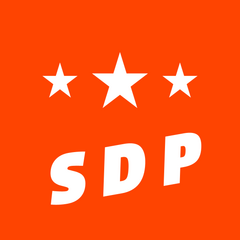Social Democratic Party of Scalizagasti
This article is incomplete because it is pending further input from participants, or it is a work-in-progress by one author. Please comment on this article's talk page to share your input, comments and questions. Note: To contribute to this article, you may need to seek help from the author(s) of this page. |
Social Democratic Party of Scalizagasti | |
|---|---|
 | |
| Abbreviation | SDP |
| Leader | Sarah Millard |
| President | Jeff Huron |
| Founded | 7 August 1891 |
| Headquarters | Bewundal, Capital Bay Territory |
| Youth wing | Social Democratic Youth Association |
| Membership (January 2015) | 289,460 |
| Ideology | Social democracy |
| Political position | Centre-left |
| Colours | Red-orange |
| Parliament | 255 / 516
|
| Provincial legislatures | 263 / 1,584
|
The Social Democratic Party of Scalizagasti (SDP) is a social democratic political party in Scalizagasti. Founded in 1862, it is the third oldest active party in Scalizagasti and the largest left-of-centre party.
History
Formation
The SDP was formed on August 7th, 1891, fifty years after the Treaty of Maldati ended the Scalizagastian Revolution. It was created by the merger of two existing organizations, the socialist Workingmen's League and the democratic anti-clerical Radical Party. It sought to represent the rapidly expanding urban working class and closely organized with labour unions.
Early years (1891-1912)
1909 "Cleaning of the House"
In 1909, party leader Anton Febvre expelled over two hundred radical members of the SDP, including leading members of the Left Faction like Lilly Terracini and Julian Hallesmann. The mass expulsion was dubbed the "Cleaning of the House" by the pro-Febvre party leadership, who often feuded with the Left Faction over policy and ideology. In the middle of the 28th SDP Party Congress, Left Faction supporters resigned en masse and left the proceedings, forming the Independent Social Democratic Labour Party (ISLP) later that evening.
The immediate cause of the initial expulsion was due to the Livorno Memorandum published by Terracini and Hallesmann, which attempted to organize revolutionary elements within the party against the reformist leadership. They planned to seize control of the party during the 28th Party Congress by denouncing Febvre's leadership and coordinating the effort to replace him with Terracini. The memorandum was leaked and the Left Faction's plans were quickly countered; anyone named in the document had their membership terminated, and suspected sympathizers to the plan also had their memberships revoked. Some suspect that Febvre used the Livorna Memorandum as a pretext to eliminate his most significant opposition within the party, regardless of their actual relationship with the plan. For example, Paul Saint-Denis, a vocal critic of Febvre, was expelled by the party despite often feuding with Hallesmann and having no affiliation with the Left Faction.